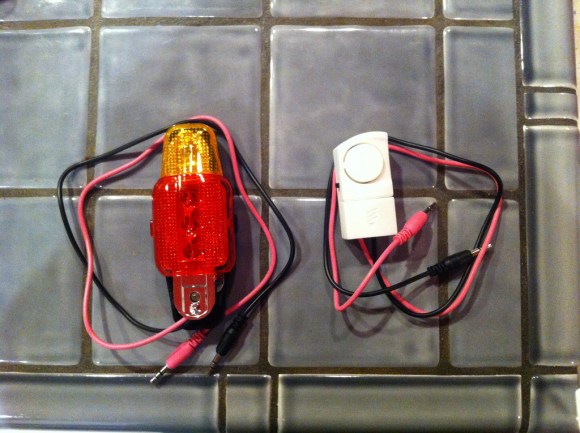
No multi-meter? For troubleshooting most household things, a continuity tester is extremely handy. And as it turns out, you can make your own from the dollar store for next to nothing.
[Carlyn] shows us how to make two different styles of continuity testers — a light up version using a bicycle light, or a buzzer version using one of those cheap window alarms. The leads are made of 1/8″ audio cables — and everything for both these testers cost less than $5 from their local dollar store. It’s a very simple build process that you can probably figure out just from this one photo, but [Carlyn] has also taken pictures of every step along the way.
Compared to building one of these out of components from Radio Shack, this method is much more MacGyver, and cheap! Hooray for taking advantage of mass produced consumer products!
Not functional enough? How about building a talking multimeter instead? No? Have you ever wanted two multi-meters in one? Say hello to the Mooshimeter!















One of the oldest hacks known to electric and electronic engineers.
5$ about 15 PLN (polish zloty)
In other words: I spend about 9 PLN on food everyday.
I’d be worried about testing anything other than cables with a DIY continuity tester like that, you wouldn’t want to put too high a voltage through a circuit and/or reverse voltage, potentially killing components in the process.
Exactly, that is why they usually use a low voltage(mV) to sense the wire. I built one of these many many years ago: http://www.electroniq.net/testers/electric-continuity-tester-circuit-diagram.html
Now in today’s world, for $5 you can throw in a coin cell, a small micro with adc, a buzzer, an led and make it tiny, auto power off, protection if you connect it to the mains by accident…. etc. Of course you need to program it, but that’s the fun of building your own.
My multimeter borked itself a couple of months ago and I wanted to check I’d definitely cut all the traces on a bit of strip board. Improvised with an led, resistor and a couple of jumper wires on a breadboard. It’s a nice handy solution if you’re in a corner.
Nowadays you can order a crappy multimeter for $10 online. Sure, it’s twice the cost of these things, but it’s a full multimeter, continuity tester mode included.
Nowadays, I look through my collection of Harbor Freight coupons, and find one for a “free” multimeter; same crappiness, and it only costs about 79 cents (because you have to buy something to use the “free” coupons; I generally go for the small captured-ball casters).
speaking of Harbor Freight coupons: [these aren’t for the multimeters but ‘no purchase required’ on a multimeter is a pretty rare find there(i’ve seen it once though), and you could modify the flashlight into a 4.5v continuity tester, or better yet, build a joule thief circuit into the flashlight body and do your continuity tests with a ‘dead’ AA]
http://images.harborfreight.com/hftweb/home-page2014/images040114/april-free-coupons.pdf These coupons expire 04/30/2014.
^^now, instead of the intended result of DLTR stock going up, Harbor Freight stock goes down, slightly?
An LED and a damn resistor with 2 AA batteries would have been a better hack than this undeserved crap on hackday! WTF is this shit being posted here for.
Sent in anything lately? Perhaps you ought to class up the joint…
…or just shut the hell up. Your call.
Thanks for posting this. I totally agree with many of the commenters here. Crazy simple, not the most correct circuit.
I took over an electronics class mid-semester and many of my student don’t have access to a multimeter. In the fall that will be a required purchase. In the meantime, I wanted to show them how easy it is to solve the continuity tester problem without screwing the students on financial aid.
The labs aren’t due until Thursday, but I’ve already got some turning testers that blow what I did away: http://pcceltn130.tumblr.com/
I use the electronics of a “music birthday card”. Solder wires to the contacts and a pin of a DIP socket to the other end as probe tips. Wrap the circuit into tape or put it into a very small zip-loc bag.
Sure, the music is annoying, but usually you stop it after the first second anyway.